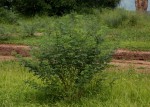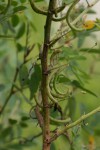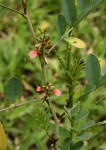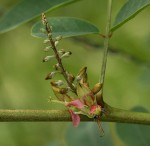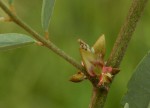Indigofera tinctoria
arcuata
Selected images: Click on each image to see a larger version and details of the record View all images (14)
Detailed records: Display species records QDS maps by: Google Maps Point records by Google Maps
Species details: Click on each item to see an explanation of that item (Note: opens a new window)
| Synonyms: |
Indigofera suffruticosa sensu Conçalves non Mill. |
| Common names: | |
| Frequency: | Locally abundant |
| Status: | Native |
| Description: |
Small shrub, usually up to c. 1 m tall. Stems and branches slightly angular. Leaves imparipinnate with 5-7 pairs of leaflets; leafltes 14-20 mm long, sparsely hairy on both surfaces. Inflorescences axillary. Flowers reddish-pink and yellowish-green, with brownish hairs on the back of the standard. Pods strongly sickle-shaped, up to c. 20 mm long, hairy. |
| Type location: |
Tanzania |
| Notes: | The species is said to have become increasingly abundant in the alluvial plains of the Mana Pools National Park. There is considerable debate on the reasons for this increase and whether it is causing any ecological damage to the area's biodiversity. |
| Derivation of specific name: | tinctoria: used as a dye. Soaking and fermenting the leaves of this species has already since ancient times been used to produce indigo dye, a distinctive blue-violet colouring. Nowadays these dyes are mostly produced synthetically. |
| Habitat: | In seasonally flooded woodland and mopane woodland, on Kalahari sands or clay, on riverbanks, cultivated areas and roadsides. |
| Altitude range: (metres) | Up to 1000 m |
| Flowering time: | (Jan-)Feb - Mar |
| Worldwide distribution: | (this variety): Angola, Ghana, Tanzania, Botswana, Malawi, Mozambique, Zambia, Zimbabwe, and Limpopo, Mpumalanga, South Africa. Var. tinctoria is widespread in Africa, Madagascar, Asia, Australasia and South America. |
| FZ divisions: | N,W,E,S |
| Growth form(s): | Shrub over 2 m. |
| Endemic status: | |
| Red data list status: | |
| Insects associated with this species: | |
| Spot characters: | Display spot characters for this species |
| Images last updated: | Saturday 3 December 2011 |
| Literature: |
Chapano, C. & Mamuto, M. (2003). Plants of the Chimanimani District National Herbarium and Botanic Garden, Zimbabwe Page 34. Drummond, R.B. (1972). A list of Rhodesian Legumes. Kirkia 8(2) Page 222. Drummond, R.B. (1975). A list of trees, shrubs and woody climbers indigenous or naturalised in Rhodesia. Kirkia 10(1) Page 245. Gillett, J.B., Polhill, R.M. & Verdcourt, B. (1971). Leguminosae (Part 3) subfamily Papilionoideae (1) Flora of Tropical East Africa Page 308. Mapaura, A. & Timberlake, J. (eds) (2004). A checklist of Zimbabwean vascular plants Southern African Botanical Diversity Network Report No. 33 Sabonet, Pretoria and Harare Page 49. Schmidt, E., Lötter, M. & McCleland, W. (2002). Trees and shrubs of Mpumalanga and Kruger National Park Jacana, Johannesburg, South Africa Pages 210 - 211. (Includes a picture). Schrire, B.D. (1998). Notes relating to the genus Indigofera (Fabaceae) for Flora Zambesiaca: 2. Section Indigofera Kew Bulletin 53(3) Page 667. Schrire, B.D. (2012). Papilionoideae-Indigofereae Flora Zambesiaca 3(4) Pages 133 - 136. (Includes a picture). Setshogo, M.P. (2005). Preliminary checklist of the plants of Botswana. Sabonet Report no. 37. Sabonet, Pretoria and Gaborone Page 68. |
Other sources of information about Indigofera tinctoria var. arcuata:
Our websites:
Flora of Botswana: Indigofera tinctoria var. arcuataFlora of Malawi: Indigofera tinctoria var. arcuata
Flora of Mozambique: Indigofera tinctoria var. arcuata
Flora of Zambia: Indigofera tinctoria var. arcuata
External websites:
African Plants: A Photo Guide (Senckenberg): Indigofera tinctoriaAfrican Plant Database: Indigofera tinctoria
BHL (Biodiversity Heritage Library): Indigofera tinctoria
EOL (Encyclopedia of Life): Indigofera tinctoria
GBIF (Global Biodiversity Information Facility): Indigofera tinctoria
Google: Web - Images - Scholar
iNaturalist: Indigofera tinctoria
IPNI (International Plant Names Index): Indigofera tinctoria
JSTOR Plant Science: Indigofera tinctoria
Mansfeld World Database of Agricultural and Horticultural Crops: Indigofera tinctoria
Plants of the World Online: Indigofera tinctoria
Tropicos: Indigofera tinctoria
Wikipedia: Indigofera tinctoria

